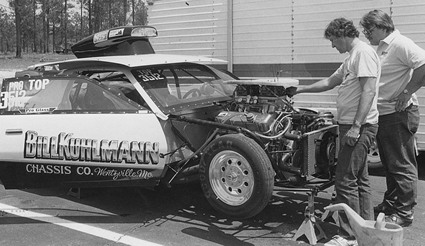|
I got better as time went on. One night a buddy of mine in a '57 Ford
was street-racing a 327-cid '62 Chevy and I was directly behind both
of them off to the side. I took off when they did and just powered by
both of them. After that, it was into the service where I rented a '66
Mustang. Compared to that old Ford, it was so fast. As soon as I got
out of the service, I went to buy a car to race. I wanted either a 427
Mustang or a 396 Chevelle, but couldn't find either. A dealer got me
to settle for a 289 Mustang, but I liked it from the start. It was snappy,
I could run with big inch cars up to the eighth mile, but on the top
end they'd power by. I decided that a Chevy was probably a better power
maker than the Ford, so some time in the late 1960s or early 1970s,
I put a small-block Chevy into the Mustang and I've been with Chevrolet
power ever since.
DRO: The first time we ever heard your name,
it was in association with a guy named John Taylor. We remember seeing
it on the 202 car. Who was he?
I've known (St. Louis chassis builder) Jerry Haas for a long time and
he introduced me to this guy, John Taylor, who owned a huge junkyard
in St. Louis. At the time, I had been driving for a lot of guys (in
the St. Louis area); I was basically a hired driver. I didn't have any
money, and certainly couldn't put together anything that could run with
the Bill Jenkins' and Reher & Morrison's, but Taylor came along with
a big-inch '81 Camaro and I eventually wound up driving it.
I think the car worked its way to Jerry Bickel's shop in 1982 or so,
and Taylor complained that no one could handle the car. His drivers
all said that there was something wrong with the car; that they couldn't
get it down the track. Well, he let me try it and I whipped it right
through the traps. The car was fine, I just think a few of those drivers
might've been a little leery about wheeling a big cubic inch car.
DRO: What was the genesis of the 202-mph car?
While I was running Taylor's car, I was building one of my own and
it would be this car that I ran 202-mph. I had just one incident with
the Taylor Camaro and it frankly was an error on my part that led to
my running 202-mph a year later in my car. I decided to put a small
wing on the rear of the Taylor car. I couldn't afford a big mountain
motor, so I figured I'd try to get by on my driving ability and go with
a four-inch rear wing because I thought the big wing slowed it down.
Well, I was at a UDRA race at St. Louis International [now Gateway International],
and at about 1,000 feet the car spun, went backwards and hit the wall.
I knew that a bigger wing - much bigger - was the way to go.
From 1984 to about 1986, Taylor and I ran match races, UDRA and the
USSC (U.S. Super Car circuit). We did okay and I think I was voted the
UDRA Rookie of the Year in 1986.
DRO: Your name is synonymous with nitroius oxide
and performance. How did you get involved with the laughing gas?
In 1986, John had a 615-cid Reher & Morrison Pro Stocker and we had
a good year with UDRA. I had always been intrigued by nitrous oxide
and wanted to try it on John's car, so I took a look at the UDRA rule
book and saw nothing that said, 'you can't use it.'
We took it to Byron Dragway in Illinois one afternoon using a nitrous
oxide system, and John's car immediately runs a 180-mph shot. So, if
nothing else, I got two ideas that would put me over the top in the
200-MPH chase.
DRO: The press was certainly aware that a 200-mph
run was coming from a "door car," but to be honest, we didn't have you
handicapped near the top because of all the more established names trying
for it. How did you pull it off?
One night, my son Barry and I got together at the shop and talked about
the possibility of being the first driver over 200-mph. All the books
and magazines had stories on it and we weren't near the top. They'd
ask would it be Rob Vandergriff, would it be Bob Glidden, Randy Hagerty,
Rickie Smith, and when it came to me, one of the books had something
written in it like, "Darkhorse has outside shot." That bit of ink got
me to thinking that I'd really like to be the first guy over 200.
I still had my own car in the shop and I told John that because it
was lighter than his (1,8000 to 2,500 pounds) I'd like to use it. I
also told them that I'd heard that Sonny Leonard's mountain motors ran
best and that I had talked with Ollie Volpe (a Leonard employee) and
he took me seriously. I had also talked with Mike Thermos at NOS and
he liked my idea of going with a big wing, big motor, and a light car.
I bought what is still your basic NOS Fogger system from Thermos, and
he thought I'd do all right given that I had run pretty fast on junk
tracks around the midwest.
John had faith in me, too. We agreed to buy a Sonny Leonard "kit" motor
for $20,000 rather than the standard fully-prepared $30,000 edition
and go for it. John okayed it and I built it.

photo by Bruce Bennett Studios
|